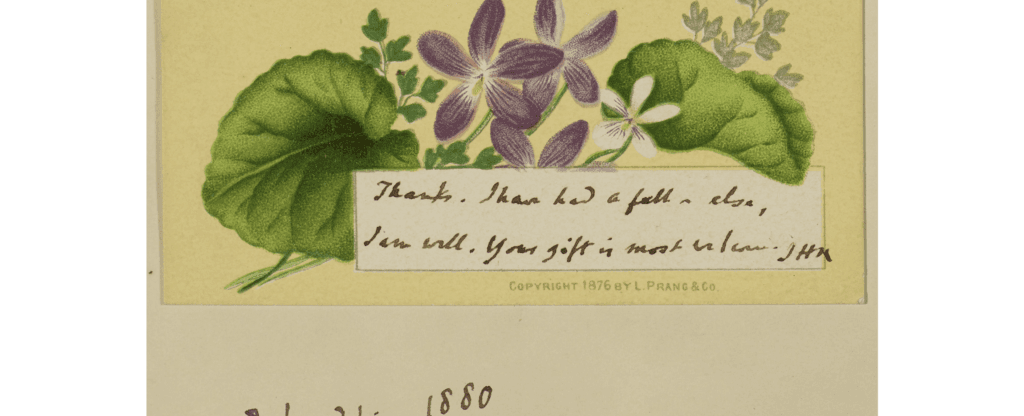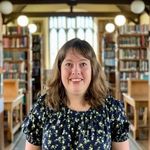Pusey House, Oxford Joins NINS Digital Collections

Digitizing our Newman archives for NINS Digital Collections was Pusey House’s first public digitization project, and it was an absolute pleasure to work on. The seeds of the project had been planted a few months before I arrived as the new Pusey House Librarian in April 2020. I soon received welcoming emails from the National Institute for Newman Studies (NINS) explaining what they wanted to do, and I was thrilled by the thought that such a large-scale, user-friendly platform could be within reach of a small institution like Pusey House. The digitization process was easy, with minimal outlay required from Pusey House. The most complicated part was making sure we unearthed everything of interest to send off to the digitization firm, but that was down to the size of the cataloguing backlog in our archive, which has only been staffed full-time since 2014. Both NINS and ICAM (the digitization firm) were lovely to work with throughout.
For readers who are interested in using the Pusey House collections for their research, here is an overview of what we have. Only original materials have been digitized, so the digital collection is slightly smaller than the physical one, but every authentic Newman item we have should now be accessible online. Anyone based near Oxford is of course very welcome to come and see the physical versions too.
NEW 1: The Copeland Collection (Newman and Pusey)
The first collection is especially significant for us at Pusey House, as it features ninety-seven letters that Newman wrote to our namesake, Dr. Edward Bouverie-Pusey (1800–1882). Pusey House was founded in 1884 to commemorate Dr. Pusey’s leading role in the Oxford Movement. Pusey and Newman together formed a powerful pair at the head of the Movement, leading to the popular contemporary terms “Puseyism” and “Newmania.”
Newman first became friends with Pusey in the mid-1820s, when the two of them were employed as theology tutors at Oriel College, Oxford. Most of the NEW 1 correspondence was written in the 1830s and 1840s and covers personal news, opinions on academic and spiritual matters, and the experience of being publicly held to account for controversial religious views. Things petered out a little after Newman’s defection to the Roman Catholic Church in 1845, but the two managed to patch up their friendship enough for Newman to offer Pusey the gift of a book in 1854.
The Copeland Collection is named after Newman and Pusey’s mutual friend William John Copeland (1804–1885), who acquired the letters after Pusey’s death and gave them to Henry Parry Liddon (1829–1890) for safekeeping. Liddon was extremely dedicated in preserving and copying any letter relating to the Oxford Movement that he could find. We are therefore fortunate also to own his transcriptions of all the letters in the Copeland Collection.
Alongside Newman’s letters to Pusey, the collection features three replies of Pusey’s and a very small sample of Newman’s correspondence with Richard Bagot and Charles Carr Clerke.
NEW 2, 3, 4, and 5: The British Critic
Records of Newman’s time as editor of The British Critic magazine form the bulk of our main Newman archive. Newman took the helm at the magazine in 1838, steering its already conservative theological content into more clearly Tractarian waters. He was able to use his influence to obtain regular articles and reviews from the leading High Church theologians, including Thomas Mozley, Edward Churton, and Dr. Pusey himself. Newman retained his editorial position until 1841, when a storm of resentment against Anglo-Catholics and his own evolving religious doubts led him to give up the position to his brother-in-law Mozley.
Pusey House’s British Critic archives are divided into four collections:
- NEW 2 contains letters that Newman wrote to eleven of the magazine’s contributors. Churton is the main correspondent, with ten letters addressed to him by Newman between March 1837 and December 1838.
- In NEW 3 are letters sent to Newman. Some are replies to letters from NEW 2, but most come from different correspondents, including the publisher Francis Rivington, the politician Sir Thomas Dyke Acland, and the great orator Bishop Samuel Wilberforce.
- NEW 4 brings together a small selection of other correspondence surrounding Newman’s editorship. There are just five letters, mainly involving Rivington as publisher of the magazine.
- NEW 5 contains typed transcriptions of some of the key letters in the preceding three collections.
In the physical box alongside these four collections are examples of Newman’s published pamphlets and his own handwritten list of the British Critic’s contributors. The Library at Pusey House is fortunate also to have a full run of the magazine for visitors who would like to explore the fruits of Newman’s editorship.
NEW 6: Newman and Plummer
Our sixth collection is from a later period in Newman’s life: 1870–1888. By this time, Newman was openly Roman Catholic and building an impressive reputation in his new church. In 1879 he would be made a Cardinal by Pope Leo XIII, in recognition of all he had done to advance the religion in Britain, through his writings, preaching, and teaching in the Catholic universities and schools.
Despite such wholehearted dedication to his new life, Newman remained in contact with many of his former Anglican colleagues in Oxford. One of these colleagues was Alfred Plummer (1841–1926), a deacon and theology lecturer at Trinity College, who moved north to become Master of University College, Durham, in 1874. Newman wrote forty-one letters to Plummer in the eighteen-year period covered by our archival collection. The letters are friendly and personal, and they spoke of Newman’s health concerns and fond memories of Oxford, as well as the major theological debates of the time. There is much discussion of controversial German theologian Dr. Ignaz von Döllinger, some of whose works Plummer was translating.
Perhaps the most attractive letter is the one dated 22 April 1870, which includes Newman’s hand-drawn floor plan of his old undergraduate accommodation at Trinity College.
NEW 7: Miscellaneous Correspondence
NEW 7 is the most varied of our collections, bringing together eleven small samples of Newman’s correspondence that do not quite fit in elsewhere. There are letters from Newman to Anglican clergymen Charles Lewis Cornish, Charles Gore, Joseph Kirkman Miller, Octavius Ogle, and Robert Francis Wilson. The Charles Gore letter is of particular interest to us at Pusey House because Gore was our first Principal, from 1884 until 1893, and went on to become Bishop of Oxford as well as founder of the Anglo-Catholic Community of the Resurrection. The other autograph items in NEW 7 are short notes that Newman wrote to antiquarians Wilfrid Wilberforce and John Henry Parker, about social and publishing matters.
Readers who come to consult this collection at Pusey House will find that the box also contains copies of other correspondence to and from Newman, most notably a glass plate negative of his famous secession letter to his sister Jemima, dated 8 October 1845.
Newman in Other Archival Collections at Pusey House
Although many of our Newman holdings are concentrated in the seven collections described above, Newman’s presence is by no means limited to those collections. We are also lucky to have the following items dispersed across other nineteenth-century archives:
- Over two hundred further letters from Newman to Pusey, painstakingly collected by Henry Parry Liddon and pasted into bound volumes. As mentioned above, Liddon was an assiduous collector and transcriber of the letters of Tractarians. For those interested in the Oxford Movement more generally, the “Liddon Bound Volumes” of correspondence—of which there are 151 in total, plus nearly a hundred further bundles of transcribed letters that were intended to be bound—are a wonderful resource, perhaps unrivalled in their subject area. They are available to consult physically at Pusey House and we hope to make them a priority for digitization in the future.
- Twenty-nine letters from an elderly Newman to his goddaughter Henrietta Woodgate (1839–1924). Given the close relationship between Newman and Woodgate, these letters are warm and personal, mainly dealing with health concerns and the affairs of the Woodgate family.
- Twenty-one letters from Newman to Edmund Salusbury Ffoulkes (1819–1894), along with two of Ffoulkes’s replies. At the time these letters were written (1861–1865), Ffoulkes had converted to Roman Catholicism, but in the 1870s he would return to the Church of England and become Vicar of the University Church of St. Mary the Virgin, Oxford. The main topic of his correspondence with Newman is the viability of establishing a Catholic university or college in Oxford. Newman was enthusiastic about this plan and went so far as to buy some land for it, but the Roman Catholic authorities did not approve, so the institution was never built.
- A scrapbook containing, among other Oxford Movement mementos, ten letters and a pretty floral thank-you card from Newman to his former curate at Littlemore, John Rouse Bloxham (1807–1891). Bloxham and Newman’s friendship survived Newman’s dramatic secession, and they remained in touch well into their old age.
- A smaller selection of letters from Newman to Anglican clergymen Thomas Henderson, Herbert Norman Evans and Francis Meyrick, Roman-Catholic aristocrat James Robert Hope-Scott, historian Sir Francis Palgrave, and various members of the Pusey family.
Conclusion
At Pusey House we are delighted to have been offered the chance to make our Newman archives more accessible through NINS Digital Collections. We hope you enjoy exploring the letters as much as we have enjoyed making our first foray into the world of digitization. We look forward to a long and happy collaboration with NINS, and we hope to be able to showcase more of our Oxford Movement archives online in the future.
Share
Jessica Woodward
Librarian at Pusey House, Oxford
Jessica Woodward is the Librarian at Pusey House. She joined in April 2020, after having worked in several Oxford University libraries. She has a BA in French and Spanish from Keble College, Oxford, and an MA in Translation from the University of Surrey. A graduate of the Bodleian Libraries’ Trainee Scheme, she is currently completing a PGDip in Information and Library Studies at the University of Aberystwyth.
Topics
Newsletter
QUICK LINKS

